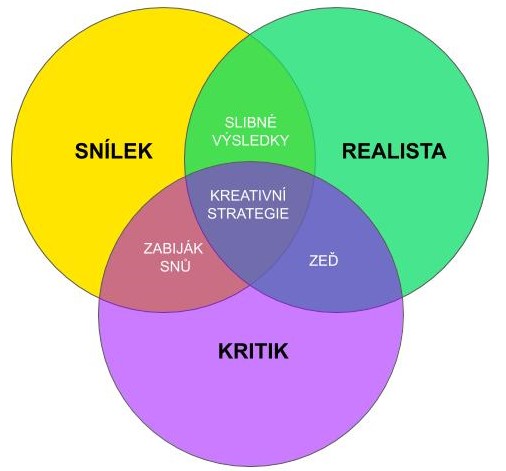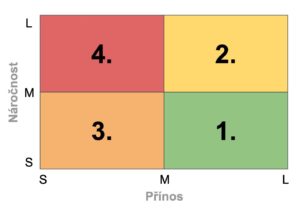“The best way to predict the future is to create it.” — Alan Kay
The first innovations triggered by the coronavirus crisis appear on the market (see e.g. company ICE and their software to collect data; or FENCY FRIES viz Forbes or more in the article Innovation in times of crisis, or what about employees when there is no work for them now by Jarka Prochazky.) But to just do a reboot of our thinking is not something we were raised or trained to do. Rather the opposite. To inspire and help you with new, perhaps important ideas and decisions for your future, we share a simple technique we have adopted for innovation workshops.
And that brings us to the person of Walt Disney. Personality certainly interesting in itself, a genius innovator in the entertainment industry who has dealt with many crises in his lifetime. But today we will focus on the method he used with his production team. It is very simple, we have been using it ourselves for over five years in our innovation workshops and we want to offer you our experience and tips that are important for its successful use.

Three Roles, Three Views
The method is based on simple principles — during brainstorming, take three different perspectives one by one. In practice, we recommend materializing them in the form of three different rooms, or different habitats within one room or hats, which we switch between during brainstorming. However, definitely do not mix these looks!

1. Dreamer
There are no restrictions in this attitude. The dreamer lives in a magical world in which everything is possible. The dreamer generates ideas -- the crazier the better. The dreamer asks:
- If there were no restrictions, if I had all the means, e.g. waving a magic wand, what would I create?
- What spontaneously comes to my mind?
- What hasn't anyone tried yet? What else hasn't occurred to anyone?
- What's the most insane thing I can think of?
What has proved useful to us in practice at this stage:
- Let the group first play some warm-up game that better “tunes” them to the dreamer's point of view — we are often so immersed in rationality and stereotype (enclosed in a box) that we lack a connection to our creativity and it is almost impossible for us to look outside of our habitual ways of thinking. The ideal is to have the group play a game that will return the participants to the age of playfulness and creativity — to childhood. At our workshops for these purposes, we play the game Hollywood (contact us for more information.)
- It is important to explicitly hold this phase for example with a measured time of 15min. Don't rush. Creativity takes time.
- There are no “buts” to this stage. Typically, we “kill” the creative with the sentence: “Yes, but...” Instead, start with “And...” and expand the original proposal or give another.
- The craziest ideas usually hide undiscovered treasure — but we have to mine it first. Let us ask ourselves: why did we think of this solution? For example, in a workshop with one client, the idea came up: let's cast molds on the moon. When asked why on the moon, the answer was simple: there is a lower gravity. Ah, gravity! How could we simulate lower gravity? Is there technology for that today? For this, we will switch to another role, to another attitude — Realist.
2. He's a realist
The dreamer does not ask if something is going or how to successfully implement something. This is what the Realist asks:
- Which of the ideas has the best chance of succeeding and at the same time has the lowest cost of implementation?
- What are the real possibilities of implementation?
- What are the limitations?
- How are we going to implement this with these restrictions?
- What's the plan?
What has worked for us in practice:
- Use the methodology at this stage The Lean Start-Up Principles and principles Agile/It's lean. That is, take an idea as a smaller or larger project, company, start-up, etc.
- Think about what a good result should look like and how we measure it, or how we know that the idea works (workshop preparation is also important here.)
- Create a basic skeleton of a solution that tells us if and at what cost we are able to create a solution. Or the output of the Realist phase can be a defined design challenge for the subsequent Design sprint.
- Identify at the beginning the main unknowns and conjectures that need to be verified.
- Define a Pilot/Test/Minimal Viable Product that verifies these assumptions.
- No plan is specific enough and does not cover everything — here it is important to agree on a common implementation procedure as we get to the result: taking small steps (Agile) and constantly checking our assumptions.
- At this stage, we “iterate” a lot, i.e. we return several times to the basis of the idea, describe several different solutions, among which we prioritize and choose e.g. help Prioritization Cross.

3. Criticism
The critic is the “devil's advocate.” The meaning and purpose of its existence is to find a reason why the chosen solution will not work or what can go wrong with it. He asks:
- What are the gaps of the chosen solution? What are we missing?
- What are the risks? What can go wrong?
- How will customers react to this?
- Why should it “work”?
- What if it doesn't work?
- Isn't there a better/other way?
Experience from practice:
- Criticism goes best to those who are not the authors of the idea. That is, at the moment it is possible to dissolve the workshop for 30 min and everyone will reach out to someone who is not involved who will give unbiased feedback.
- Critic isn't personal -- feedback doesn't mean there's anything wrong with the chosen idea or path or even us. Criticism is not meant to lead to a defense.
- Often a critic is a parental voice in our head that we can react to unconsciously emotionally (including trying to displace it). It is absolutely important for workshop facilitators to create a safe space and look at the form of feedback.
Finally, the most important thing — preparation
Preparation is crucial for the success of the whole workshop — precise definition of the good outcome of the workshop and the problem for which we are looking for a solution. It is also important to prepare a context for brainstorming, e.g. collecting important data that is related to the problem.
Equally important is the choice and number of participants. The group should be represented by different roles that will give a comprehensive view of the problem and its solution. The ideal is a group of 5-7 people (excluding facilitators), the maximum number is between 12-15 people.
“You don't have to change anything. Survival is not compulsory.” — W.E.Deming
How to prepare a plan for a totally uncertain future? The best plan is one that contains the ability to change and adapt at any time. A plan that allows you to experiment, learn quickly, quickly change decisions. We also covered this topic in an article from 2018 How to capitalize on the future.
But an uncertain future also opens up the possibility of figuring out what such a future might look like. We are confident that the current stage will survive those companies that will be able to come up with new solutions and will quickly be able to throw these solutions away if they are not operational.
The crucial thing is to take steps in the here and now instead of worrying about the future. This simple technique is worth trying. Contact us with your questions via the contact form http://rainfellows.cz/. It costs you nothing, you just need to write a question.

